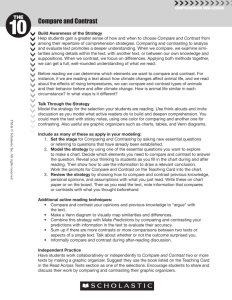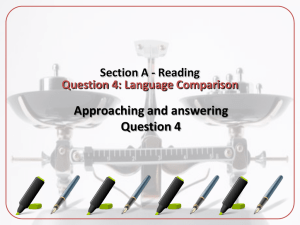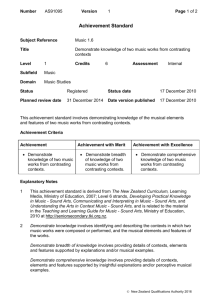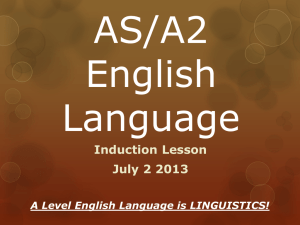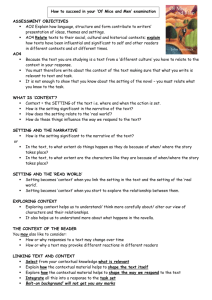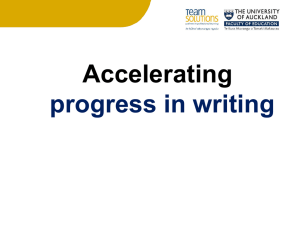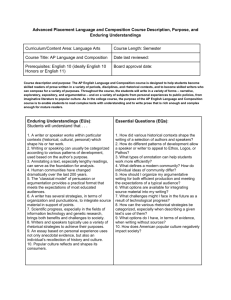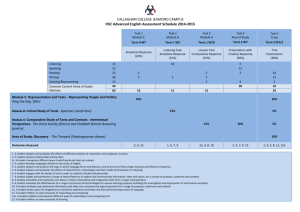Recipes Essay Mark Scheme
advertisement
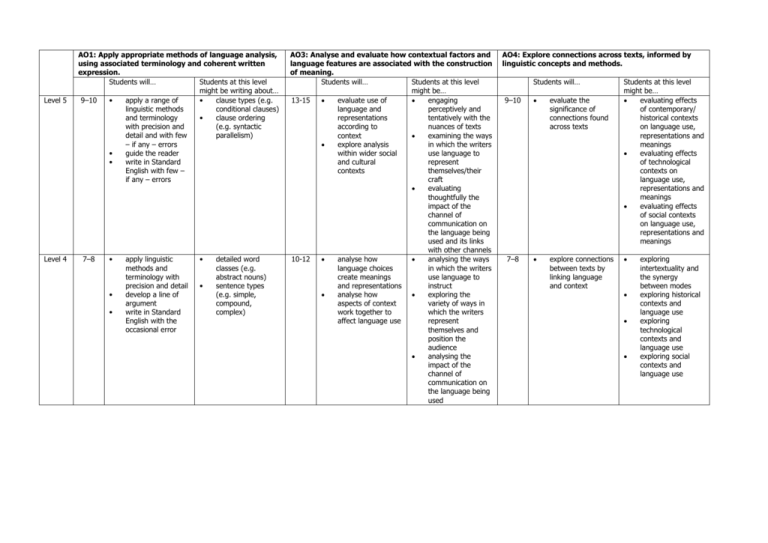
Level 5 Level 4 AO1: Apply appropriate methods of language analysis, using associated terminology and coherent written expression. Students will… Students at this level might be writing about… 9–10 • apply a range of • clause types (e.g. linguistic methods conditional clauses) and terminology • clause ordering with precision and (e.g. syntactic detail and with few parallelism) – if any – errors • guide the reader • write in Standard English with few – if any – errors 7–8 • • • apply linguistic methods and terminology with precision and detail develop a line of argument write in Standard English with the occasional error • • detailed word classes (e.g. abstract nouns) sentence types (e.g. simple, compound, complex) AO3: Analyse and evaluate how contextual factors and language features are associated with the construction of meaning. Students will… Students at this level might be… 13-15 evaluate use of engaging language and perceptively and representations tentatively with the according to nuances of texts context examining the ways explore analysis in which the writers within wider social use language to and cultural represent contexts themselves/their craft evaluating thoughtfully the impact of the channel of communication on the language being used and its links with other channels 10-12 analyse how analysing the ways language choices in which the writers create meanings use language to and representations instruct analyse how exploring the aspects of context variety of ways in work together to which the writers affect language use represent themselves and position the audience analysing the impact of the channel of communication on the language being used AO4: Explore connections across texts, informed by linguistic concepts and methods. Students will… 9–10 evaluate the significance of connections found across texts 7–8 explore connections between texts by linking language and context Students at this level might be… evaluating effects of contemporary/ historical contexts on language use, representations and meanings evaluating effects of technological contexts on language use, representations and meanings evaluating effects of social contexts on language use, representations and meanings exploring intertextuality and the synergy between modes exploring historical contexts and language use exploring technological contexts and language use exploring social contexts and language use Level 3 5–6 • • • apply linguistic methods and terminology consistently and appropriately label features with more accuracy than inaccuracy communicate with clear topics and paragraphs • • • word classes (e.g. nouns) sentence functions (e.g. declaratives) graphological features (e.g. emoticons) 7-9 interpret significance of specific choices of language according to context link specific language choices with an aspect of context discussing some of the language choices of the writers in relation to their purpose(s) and audience considering the choice of channel without reference to specific language choices 5–6 make connections across texts by identifying similar or different uses of language/content/c ontext Level 2 3–4 Level 1 1–2 use linguistic methods and terminology inconsistency and sometimes without value generalise about language use with limited/unclear evidence express ideas with organisation emerging quote or identify features of language without linguistic description present material with limited organisation general terms (e.g. ‘sentence’ and ‘word’) formality and complexity at a very general level 4-6 quotations without any linguistic description 1–3 identify distinctive features of language and significant aspects of context paraphrase or describe content of texts misunderstand text or context discussing the topic(s) of cookery in a broad way engaging with the writers’ purpose(s) but with limited reference to language use 3–4 describing the recipes without focusing on how and why the writers are using language to achieve purpose(s) 1–2 make connections at a literal level discuss relevant aspects of texts without making connections explicitly contrasting use of direct address contrasting use of sentence types and functions comparing and contrasting vocabulary used to describe cookery comparing and contrasting use of standard and nonstandard English comparing and contrasting other uses of language comparing topics comparing purposes to instruct/interact contrasting audiences/users contrasting writers/producers making one/two explicit connections making implicit connections
